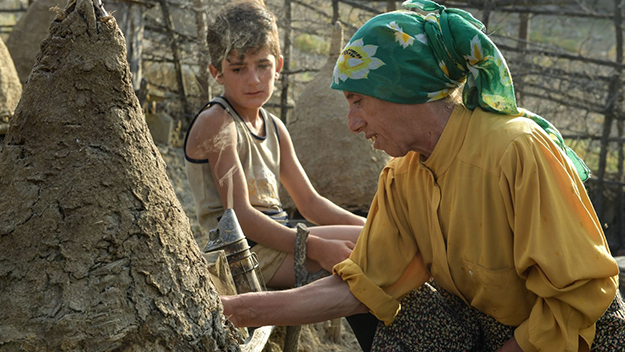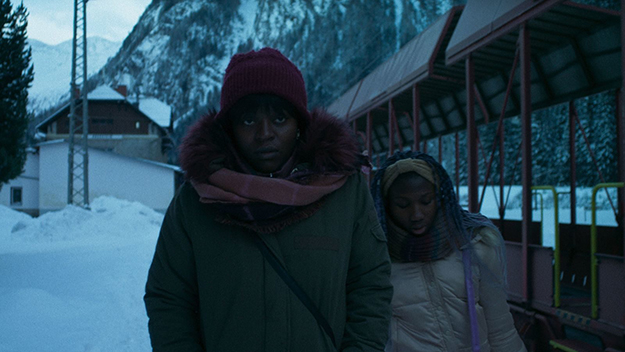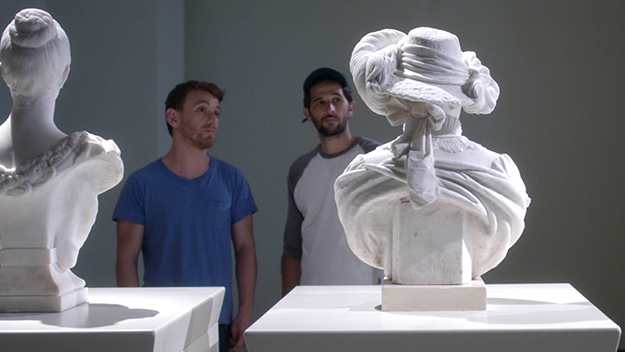ND/NF Voices: Honeyland, Joy, End of the Century

Honeyland (Ljubomir Stefanov & Tamara Kotevska, 2019)
Honeyland
Set in a remote and under-resourced village in the Macedonian Balkans, Tamara Kotevska and Ljubomir Stefanov’s Honeyland is part environmental documentary and part epic testament to the lives of its beguiling subjects. Hatidze spends her days caring for her elderly and bed-bound mother Nazife, carefully washing her hair, changing the dressing on her wounds, and feeding her bananas and spoonfuls of the honey she methodically harvests from the mountains and man-made hives she has built next to their ramshackle house. The pair’s routine is suddenly interrupted by the arrival of a nomadic family who comes bearing a clamorous herd of cattle and seven vivacious children. Though Hatidze warmly embraces her new neighbors, her way of life and survival comes under threat when the family’s patriarch begins harvesting his own honey through unsustainable methods.
Speaking in an interview with Film Comment, Stefanov explained that they met Hatidze while the directors were searching for a topic on which to base a nature conservation documentary. “We spotted those holes in the rocks, the natural beehives,” Stefanov said, during their foray into the mountains, “and soon after that, we found the person who was caring for the beehives. And it was Hatidze.” From there, Stefanov and Kotevska spent each weekend over a period of six months observing Hatidze and Nazife in their village. With the arrival of the nomadic family, the directors decided to follow the story of the conflict that arose between them, documenting their lives across three years.
What emerges is a documentary that possesses such a powerful narrative arc, and such richly and complexly realized characters, that it feels closer to a work of fiction. Kotevska elucidated the dual impulse that defines the film, explaining that Stefanov “was always more focused on the environmental approach of it, the correctness of events, and finding the most authentic way of showing them,” while she herself, coming out of a film school education, was drawn to develop the story and characters within the scope of a “fiction arc.” Through this finely tuned balancing act, Honeyland becomes a polemic against environmental abuse and overuse, as well as a tribute to the sanctity of lives lived with dignity and in communion.

Joy (Sudabeh Mortezai, 2018)
Joy
Sudabeh Mortezai’s second feature, Joy, observes a community of Nigerian sex workers in Vienna, centring around the experiences of the film’s eponymous protagonist Joy (Joy Anwulika Alphonsus) and her newly appointed charge Precious (Precious Mariam Sanusi). Joy examines the various power structures that bind the women to prostitution, the Madam (herself a previous sex worker) who controls them through crippling debt, the Juju rituals performed upon the women in Nigeria before they travel to Europe, and the European immigration restrictions that prevent them from accessing alternative forms of employment and security. Joy was cast with non-professional actors and Mortezai shot the film in chronological order, allowing her actors to improvise over the script but keeping them unaware of the film’s narrative trajectory during the shoot. As a result, Joy unfolds with a bracing immediacy and its characters’ emotions are experienced with challenging and necessary intimacy.
Mortezai was drawn to make the film because of the distinctly female power structures that exist within the Nigerian sex workers’ community in Europe. “For me, what was really striking and interesting was this cycle of exploitation with all female protagonists,” she told Film Comment. “I thought, that’s the story I want to tell because you don’t see something like that, it’s almost unimaginable.” Within this cycle, traditional understandings of the victim-exploiter relationship become deeply problematized and the audience is asked to identify with characters who refuse to fit easily into this fictionalized dichotomy. Mortezai explains that it is “very difficult to find out who is the exploiter and who is the victim, because everyone is at some point maybe both in this kind of cycle.”
In light of the urgent debates around sexual violence and the ways in which women’s bodies are represented on screen, Mortezai offers a feminist angle through which viewers can engage emotionally and cognitively with these issues, without directly depicting the violence itself. Mortezai explained that, from the outset, “it was really clear that the subject of sexual violence against women has to be in the film, it’s an important issue. But I didn’t want to objectify my actors and the women, yet again, through making the film . . . I was very clear about how I was going to show this without actually showing it.” Joy is a challenge to the systemic structures and erroneous definitions of victimhood that nurture and sustain exploitation, offering space through fiction to rethink these realities.

End of the Century (Lucio Castro, 2019)
End of the Century
In Lucio Castro’s debut feature End of the Century, two men, Ocho (Juan Barberini) and Javi (Ramón Pujol), meet by chance in Barcelona—one is traveling there for work, the other visiting the city where he was born but no longer lives. In an impeccably clean and emphatically anonymous Airbnb, the two men have sex, part ways, and then return to share wine and stories about their lives. The film’s settings of rented apartments, parks, and museums are markedly nondescript. “There is no ownership, no roots, the spaces are transient,” Castro told Film Comment. “These [locations] were interesting for me as a way to tell this story of these two characters.”
Unmoored from their everyday lives, and operating in fleeting, unclaimed spaces, both men speak to one another as total strangers, until one confesses to remembering their first encounter 20 years previously. From here on, the film’s relationship with time begins to disassemble, and we are brought into an unidentifiable past in which the pair first meet. Castro deliberated with his actors on how to shoot these particular scenes. “We were deciding if we were going to shoot it with a different light, or would he shave or have shorter hair, and then we started talking about how when you remember yourself in the past, you always think of yourself as the way you are now . . . That’s when I became really interested in this format, that time goes almost on a horizontal plane.”
In the film’s realm, memory and lived experience become indecipherable from one another, and a new kind of fantasy emerges within an ostensibly real space. The dichotomy between the detailed realism of the film’s setting and the abstract, almost dream-like space that the narrative enters into came about organically during the writing process. Castro explained that he wrote the screenplay without knowing where the story would go, beginning as if it were a diary in which mundane activities are carefully observed. “I liked the idea of something being totally concrete, in that diary format, and then it started going into things that are a little bit less concrete. I guess things start to break apart a little bit,” he said. End of the Century parses the minutiae of the everyday, gently observing the disjunctures between personal memory and lived experience as they arise through intimate connection.
Naomi Keenan O’Shea is an Irish writer currently based in Brooklyn. She studied Film and English Literature at Trinity College Dublin.







